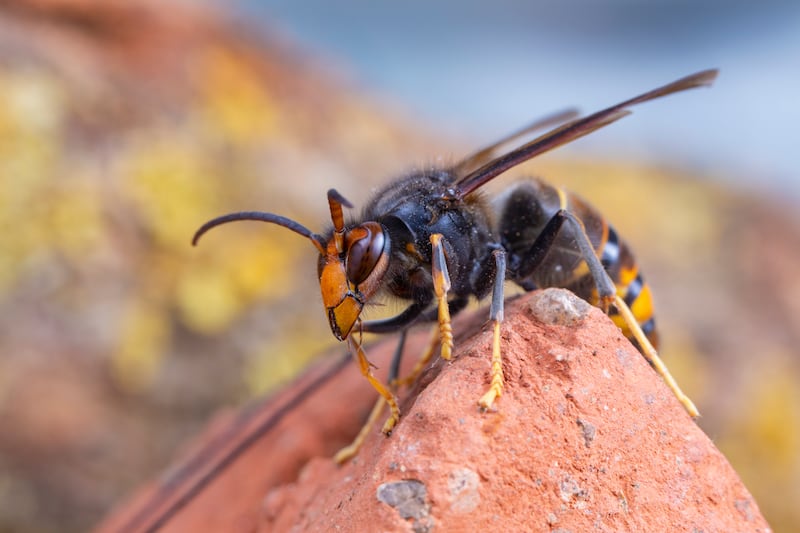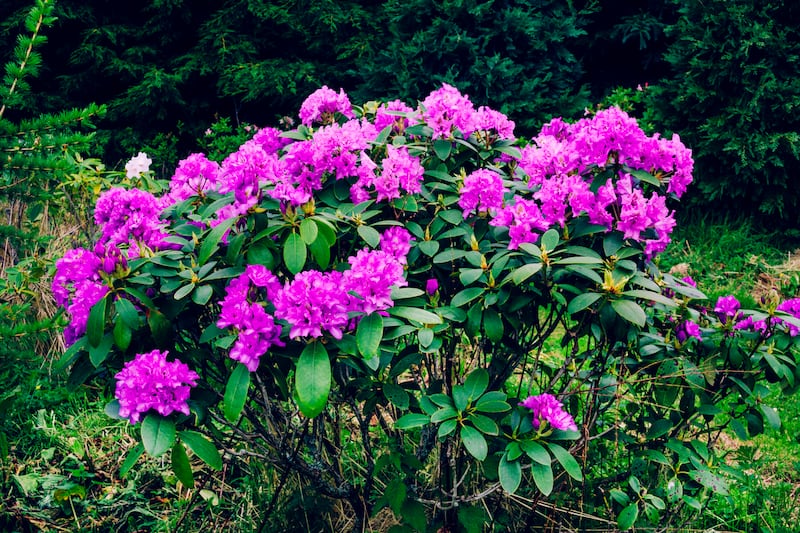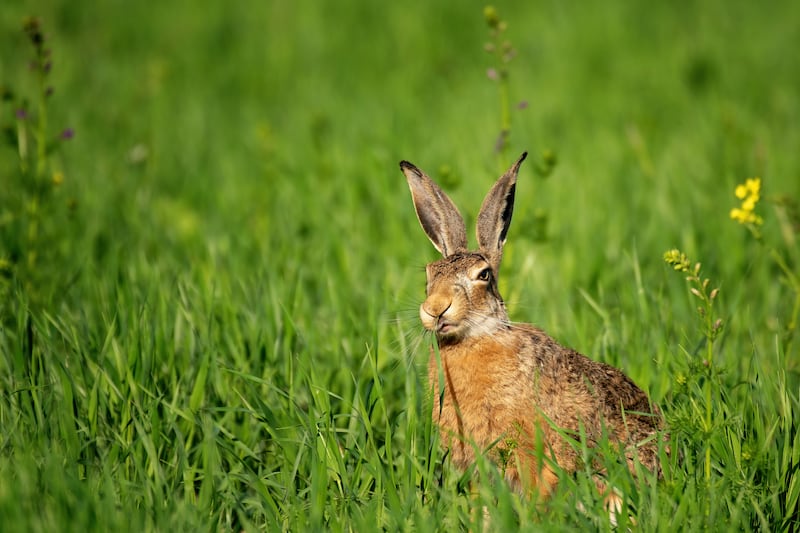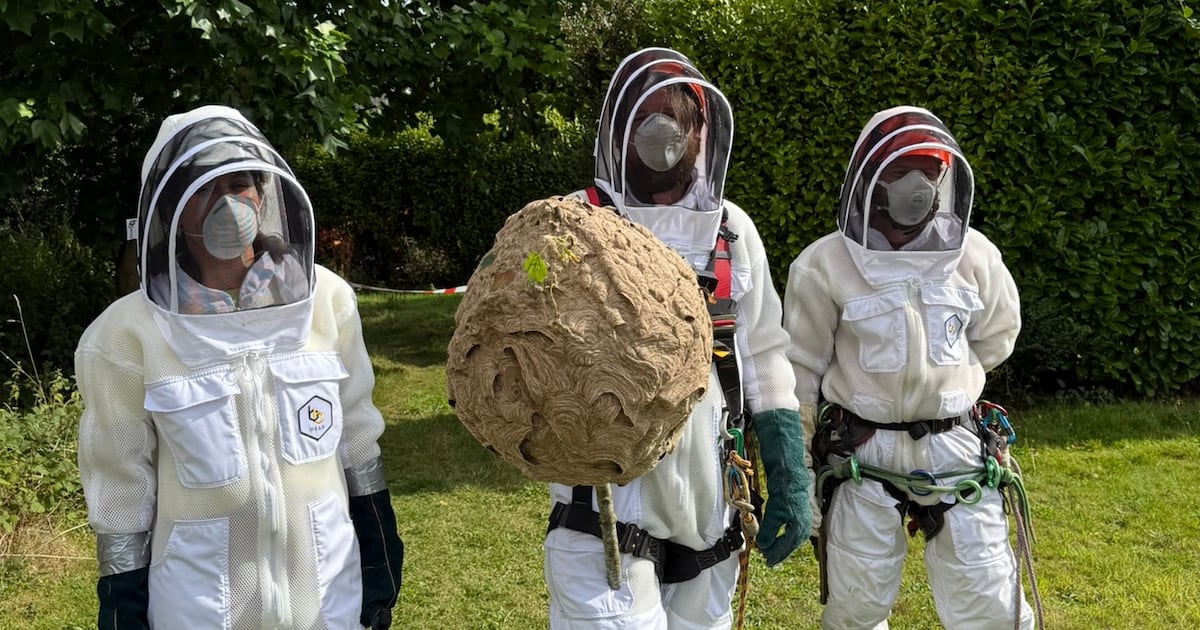If David O’Leary hadn’t let his eye wander in a suburban beer garden last summer, the battle against a voracious predator might have been over before it began.
The creature was resting on a flagstone close to where he sat and O’Leary just had time to snap two hurried photographs before it flew off.
“It was tasting something on the ground,” the biologist who works in the School of Medicine at University College Cork recalls.
“There were wasps around because there’s ivy in the garden and it was flowering at the time, but this was twice their size.”
If the size of the winged creature caught his attention, the yellow legs and orange face held it.
“I Googled it and I was fairly certain what it was.”
O’Leary’s phone call to the National Biodiversity Data Centre (NBDC) was one the staff there both dreaded and were glad to receive.
They had suspected for some time that the Asian Hornet was either in Ireland or on its way.
 An Asian hornet (Vespa velutina).
An Asian hornet (Vespa velutina).
Now their fears were confirmed but at least they knew where to start looking.
The hunt that began that day grabbed the public’s attention in a way no other invasive species alert did before.
The hornet’s fearsome reputation as a devourer of native bees rallied support for its capture.
The audacious manner in which it built its elaborate nest in the tree of a Cork family’s back garden was fascinating.
The forensic surveillance and trapping operation jointly undertaken by multiple agencies and experts to track, isolate and neutralise the threat was as compelling as a true crime saga.
But the crime scene expanded. Another nest was later found 20km away in Cobh and last weekend a nest was discovered on the outskirts of Belfast.
And it’s not the only invasive species to worry about.
[ Agency in North seeks Asian hornet advice from Waterford centreOpens in new window ]
Since the Asian Hornet’s moment of fame, the NBDC has issued another alert, this time for the Demon Shrimp.
It was detected in late September in the Shannon below Lough Derg and while it is unknown how it got to Ireland from its Black Sea stronghold, it is “likely to have hitchhiked on watercraft or angling equipment”.
Highly adaptable and a prolific breeder with an appetite for shrimp flesh of local varieties, it could massively disrupt the food chains and ecosystems of rivers and lakes where nature is already struggling.
But at just 18mm long, almost transparent in colour and residing underwater, it won’t be making any high-profile appearance in Coughlan’s beer garden.
The invisibility of many invasive species to the general public makes preventing their spread more difficult.
“Anything that occurs below the water surface is not seen by many of the public,” says John Kelly, invasive species programme manager at the NBDC.
“So the best we can do is keep these species out, which is why everybody needs to practice biosecurity.”
Biosecurity means measures to prevent the accidental or deliberate introduction or spread of plants, animals and pathogens to places where they do not naturally occur and where they are likely to cause harm.
On the evidence to date, Ireland needs to take more such measures.
Almost 1,300 non-native species are established in the country, most of them without causing much disruption, but around 50, labelled invasive alien species (IAS), are troublemakers.
Some are so familiar that they have worked their way into the country’s affection.
The rhododendron, famed for its fabulous flowers, and the grey squirrel, with its bold behaviour and entertaining antics, are examples.
 The Rhododendron ponticum in the summer bears pretty purples flowers which belie the damage they cause. Photograph: iStock/Getty Images
The Rhododendron ponticum in the summer bears pretty purples flowers which belie the damage they cause. Photograph: iStock/Getty Images
The former has aggressively pushed out Irish trees and plants and the latter has all but replaced the native red squirrel.
More recently, coypus, raccoons and wild boar have joined the high-risk IAS list, their appearance in the wild presumed to be the result of escape from exotic pet owners.
The European brown hare is also now in Ireland, threatening the smaller native Irish hare.
“We believe it was brought over for coursing,” says Kelly with a sigh.
Zebra mussel, quagga mussel, Asian clam and various other aquatic creatures that cause havoc in Ireland’s freshwater habitats, most likely came attached to boats or fishing equipment.
Climate change is exacerbating the problem by altering habitats and habits in the natural world.
“Some species will come because of the warming climate,” Mr Kelly says.
“They might not be able to survive here today but as the climate warms up, they might be able to survive and reproduce.
“In the marine environment, we’re getting more marine heatwaves that can lead to stress on native species while providing the conditions non-native species like.”
Global shipping, passenger ferries and recreational yachting provide stowaway opportunities for invasive species, and tourists can also be unwitting facilitators.
Dr Domhnall Melly, lecturer in tourism at the Atlantic Technical University, makes the case for having a national biosecurity strategy, covering over all the ways invasive species can enter Ireland, including tourism.
 Wild European hare. Photograph: iStock
Wild European hare. Photograph: iStock
With hiking, biking, angling and water sports of increasing importance to tourism, he says the risks of accidentally introducing a harmful species needs to be better communicated to visitors.
He says information about checking equipment and cleaning mud off footwear and gear should be included at every stage of a visitor’s journey – through their tour operator, on pre-arrival cards and at the point of arrival.
Mobile apps, common in New Zealand, could be a good tool for reinforcing the message during a visitor’s stay.
“It has to be done in a way that harmonises good biosecurity practice with the activities that tourists are engaging in,” he said.
“Ultimately if we continue on the route of introducing invasive species, we lose the very environment that brings people here.”
Education and communication campaigns have been used before.
The National Parks and Wildlife Service (NPWS) with Inland Fisheries Ireland, the NBDC and other agencies have run ‘check, clean, dry’ campaigns at locations of concern, urging boat owners and anglers to sanitise their equipment before moving from land to water and back.
The European Commission said more robust action was needed and referred Ireland to the EU Court of Justice in 2023 for failing to introduce stronger legislation with penalties for offenders.
In 2024, the Government responded by introducing the European Union (Invasive Alien Species) Regulations.
The Department of Housing which oversees the issue said: “Work on implementation of these new regulations is under way.”
Older regulations, including the Wildlife Act, were also meant to control invasive species but the department said the NPWS had “no record of prosecutions or convictions under IAS regulations”.
Regulation and education will be increasingly important as Kelly says a “whole host” of new invasive species are making their way closer to Ireland.
But so too will observation, which is where people like O’Leary come in.
“Whatever Asian hornet queens that weren’t got in the nests are hibernating now but they’ll be out next spring so I really hope there’s a good public awareness campaign then to alert people,” he said.
“If I’d been buried in my phone instead of looking around me and if I hadn’t been able to grab a photo, we might have been none the wiser that the hornet was here until it was too late. That’s leaving a lot to chance.”

